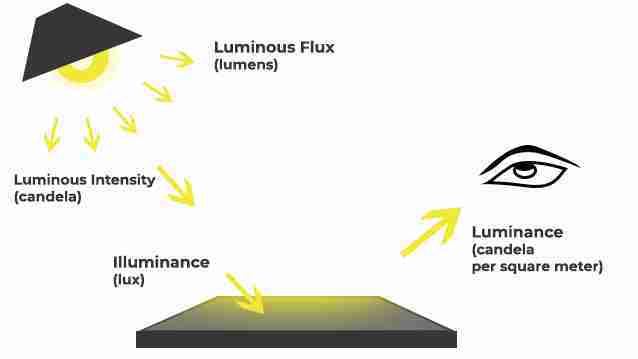Comparing lux vs. lumens projector is not quite right. They are related, but only in that, they both measure the light produced by the light source. When choosing a projector, checking the lumens it can produce is the only accurate way to determine its brightness.
While the two terms are correlated, there is some significant difference in measuring a projector screen’s brightness.
Lux vs. Lumen vs. ANSI lumens
Lux, lumens, and lumens of ANSI units are related to light projectors. Although they share a few similarities, they differ in some ways.
Lux is used to measure the amount of light emitted in a given area – 1 lux is equal to 1 lumen per square meter. It enables us to measure the total “amount” of available light and the intensity of light on the surface. An additional definition of lux is the amount of light emitted by a source after considering your spread over lux place.
Lumen is the amount of light released by a light source and considers the human eye’s sensitivity. If the projector is away from the screen, the image is larger, and the lux will be lower.

ANSI lumens determine the most accurate unit of measurement for a projector light. You will see older projects with only lumen measurements that are often wrong. However, with an ANSI lumen, you will be able to understand the power of a particular projector more reliably.
A Number of Lux Projectors Needed:
- Home theater: It functions best at 2,500 to 5500 lux of brightness to make your projector image appear accurately in daylight.
- Gaming: Gamers play games mostly in their basement, so anything between 2500 to 7500 lux should work out fine.
- Portable: A minimum of 6500 lux is enough for business purposes and personal use
A Number of Lumen Projectors Needed:
- Home theater: it generally starts at about 2500 lumens and ranges upwards to 4000 lumens
- Gaming: A light-controlled room like a gaming room around 2000 to 2500 lumens will be fine with a gaming projector
- Portable: For high-quality viewing, consider 2,500 lumens to 3000 lumens so that surrounding light won’t disturb picture quality
Lux vs Lumen Projector – Comparison Table
| Projector | Lux | Lumen | Color quality | Resolution | Price |
| Hometheater | 5500 max | 2500 max | High | 1024 | 109$ |
| Gaming | 7500 max | 2000 to 2500 | Very high | 748 | 599$ |
| Portable | 6500 max | 2500 to 4000 | Very high | 800 | 299$ |
| Mini | 2000 max | Up to 4000 | Moderate | 600 | 155$ |
Importance of Lux vs. Lumens

When to use Lux
Lux is important to know how bright a particular place looks. However, it is an important metric to understand how the surface will appear, such as a tablet, reading materials, or photography lessons.
Without a good level of lux, it can be difficult to read or watch videos in good picture quality. In general, Lux is a measure of how much light falls on a particular area and can be the result of many fluorescent lamps even with daylight mixed with it.
When to use Lumens
On the other hand, lumens are essential in determining how much light emanates from a single light source. It is useful in comparing the total amount of light emitted by a lamp, but it cannot be determined depending on the distribution of light and the size of the space.
[acf field=”faq”]Lux vs Lumens Projector – FAQs
Q: How can I convert lux to lumens?
A: The basic conversion rate from the maximum required level to the required range is 1 lux = 1 lumen per square meter. This equates to 1 lux = 0.0929 lumens per square foot.
Q: What is an adequate amount of lux a projector needs?
A: Previously it was common for light levels in 1000 – 2500 lux for normal activities. Today the light intensity is very high at 6500 – 7500 lux – depending on the function.
Q: How to obtain brighter light?
A: Brightness depends upon lumens. To be precise, lumens measure the amount of light your product output emits. The higher the lumens, the brighter the light.
Q: How many lumens are necessary for a projector?
A: For home theater projectors where ambient light is kept low, you will need at least 1500 lumens. For classrooms, conference rooms, or rooms with windows, a projector with at least 2500 lumens is best.
Q: How many ANSI lumens are good?
A: The dimensions of the ANSI lumen are the same as that of the lumen. For smaller settings like a meeting room or classroom, 3000 to 4000 ANSI lumens are ideal.
1080p vs 1440p vs 4k Resolution
